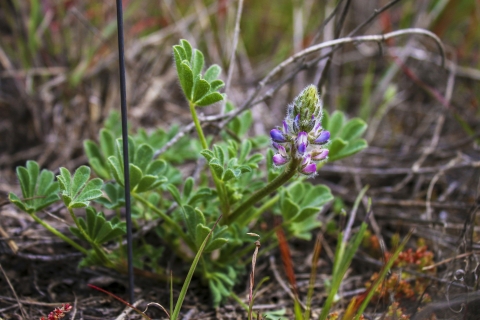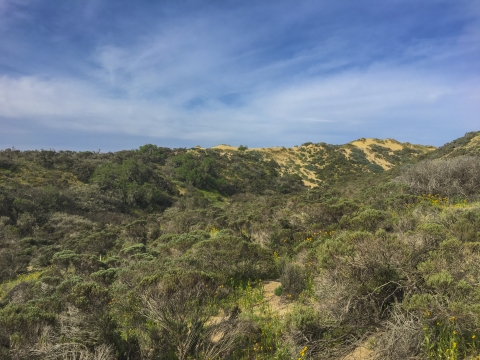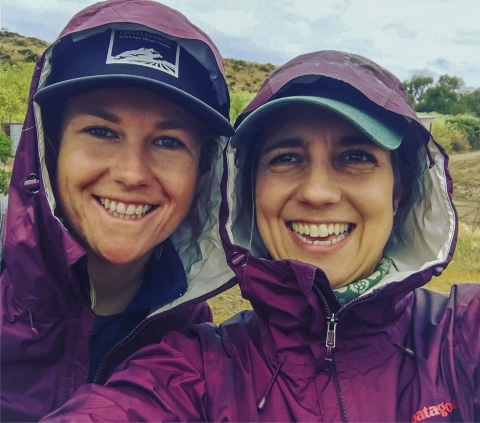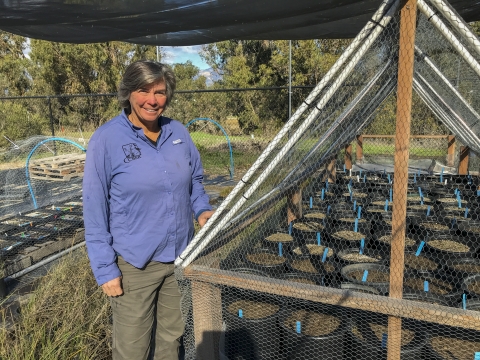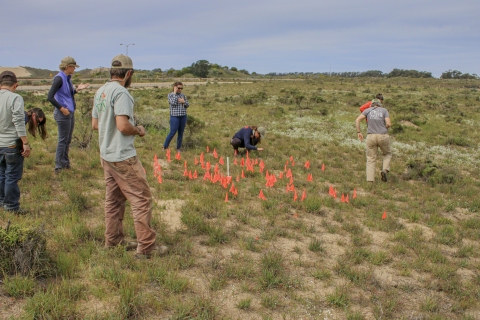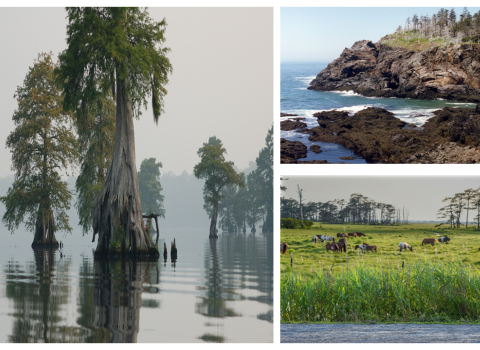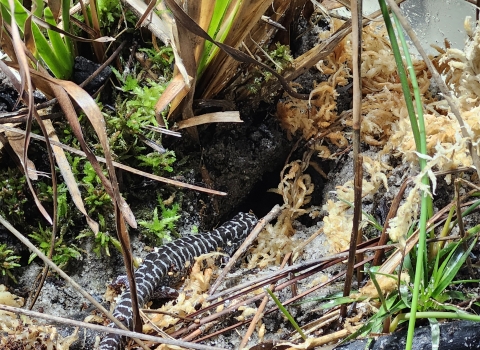By Lisa Cox and Ashley McConnell
U.S. Fish and Wildlife Service botanist, Kristie Scarazzo stoops to the ground to eye a short, hairy little plant with hand-like leaves. She’s at the base of a towering sand dune that provides the lupine and her shelter from the whipping wind, blowing sand and bright sun.
“The dunes are magical,” says Scarazzo. “They are like no place else on earth. When I am out here my heart rate goes down and I forget all about myself. There is a vast, peaceful calm.”
Sometimes, after a long day in the field, she still sees the vivid yellows, hot pinks and purples, cream whites and sage greens of the wildflowers that pepper these dunes in the early spring when she closes her eyes. It’s a transformative experience.
Today Scarazzo is surveying for Nipomo Mesa lupine, an endangered plant that is endemic to the Guadalupe-Nipomo Dunes that extend along the coast, west of the small agricultural town of Nipomo, in rural, southwestern San Luis Obispo County. This member of the legume family grows no taller than eight inches and has purple and pink-colored blossoms. Its’ entire geographic range extends only two square miles and it occurs no place else on earth.
Scarazzo is working with a collaborating team of scientists and stakeholders to develop and implement a draft recovery plan for the species, which is a long-term strategy designed to save it from extinction. There is only one population, comprised of two colonies; one of which was established by the team via experimental outplanting. Data suggests that the population is hovering at around 1,000 individuals in any given year. However, the population is vulnerable to stochastic events, such as drought because it is so small and restricted geographically.
“We are much more powerful working as a collaborative team,” Scarazzo says.
Lindsey Roddick is a senior restoration ecologist for the Land Conservancy of San Luis Obispo County that’s part of the team who has been paramount for collecting survey data and conducting research on the lupine in support of its recovery. She coordinates with landowners and other team researchers to maximize potential benefits for the species.
“As a land trust, we collaborate with private landowners to maximize our conservation impact. Without the support of the private landowners and local stakeholders, we wouldn’t be where we are today for Nipomo Mesa lupine,” Roddick says. She worked with private landowners and managers like Conoco Phillips and a cattle rancher to establish a seasonally timed grazing plan for weed management and for most of the grazing to occur outside the lupine growing season. The fostering of this working relationship has been one of the most important things for the species recovery.
During the summer and fall, cattle grazing hoof punches (marks made in the ground by cattle hooves) provide an essential disturbance to help the lupine thrive and the cows nip the veldt grass down before it can go to flower and reproduce. “The cattle grazing has really helped level the playing field and helps ensure that the annual lupines reach maturity and set as much seed as possible,” Roddick says. “We use many methods to protect the Nipomo lupine from invasive species invasive species
An invasive species is any plant or animal that has spread or been introduced into a new area where they are, or could, cause harm to the environment, economy, or human, animal, or plant health. Their unwelcome presence can destroy ecosystems and cost millions of dollars.
Learn more about invasive species . Every tool in the toolbox is necessary to ensure their success whether it be hand pulling, grazing, or grass-specific herbicide to further combat the spread of veldt in areas occupied by the lupine.”
“Displacement from invasive perennial veldt grass is the biggest challenge facing the Nipomo Mesa lupine today,” Scarazzo explains. It was introduced in the 1950s as a forage and to stabilize the dunes. And this grass, native to South Africa has succeeded in doing exactly that. It outcompetes native coastal dune scrub species for critical resources and prematurely stabilizes the dynamic ecological dune processes that are essential for this ecosystem to function.
“Soil stabilization is the opposite of what these dunes need,” says Lisa Stratton, director of the Cheadle Center for Biodiversity and Ecological Restoration at University of California, Santa Barbara who is also on the lupine recovery team. “This dynamic ecosystem is active and requires periodic disturbance to stay healthy; the plants within these dune communities are adapted to that regime.” Nipomo Mesa lupine requires open patches within coastal dune scrub habitats that are created by the wind and moving sand.
Stratton works with graduate students to better understand the lupine’s life history and ecological requirements and she’s been leading research on the species seed germination, seed banking and propagation since 2012.
Stratton and her team learned that the seeds require scarification with sand paper, which mimics the scraping caused by wind-blown sand on the outer surface of the seeds and makes it easier for them to sprout in otherwise suitable habitats.
“We’re getting to the point where we know the best microclimate conditions and timing for outplanting in the wild,” Stratton says. “If we can continue to secure grant funding, we can disperse the seeds we’ve been bulking and establish several more new occurrences throughout the species historic range.” Stratton worked with Roddick and the Service to establish an experimental population at the Land Conservancy’s Black Lake Ecological Area and it has been viable since 2015.
Scarazzo, Roddick and Stratton have developed an unbreakable bond to save the Nipomo Mesa lupine and its dune habitat for generations to come. They’ve all been inspired by the activists and scientists who came before them that worked to preserve and better understand these dunes, especially Kathleen Goddard Jones. “There are thousands of miles of seacoast in California, but there are only a tiny few places where sand dunes still build, still move unfettered. Still hold their wild enchantment,” said Goddard Jones in her biography, Defender of the Dunes, by Virginia Cornell (2001).
Goddard Jones passed in 2001 and spoke of the same enchantment with the dunes that others speak of today. “It’s almost as if she is still with us,” says Scarazzo. “We share the same joy when we see the dune wildflowers each spring and know that Goddard Jones walked along many of these same trails. Her spirit is very much still here.”
The Nipomo Mesa lupine, an endangered plant that is endemic to the Guadalupe-Nipomo Dunes, grows no taller than eight inches and has purple and pink-colored blossoms. Its’ entire geographic range extends only two square miles and it occurs no place else on earth. Photo courtesy of the Land Conservancy of San Luis Obispo County.
“I hope that when I’m 92, I’ll still be trudging around these dunes like Kathleen did, encouraging the next generation of people to protect them,” says Roddick.
In the 1960s, Goddard Jones’ power of persuasion and unwaveringness to educate the community about the dunes inspired others to join her cause when development of a nuclear power plant threatened their development. She later championed the establishment of several state and county parks, designation of a dunes National Natural Landmark National Natural Landmark
The National Natural Landmarks Program preserves sites illustrating the geological and ecological character of the United States. The program aims to enhance the scientific and educational value of the preserved sites, strengthen public appreciation of natural history and foster a greater concern for the conservation of the nation’s natural heritage. The program was established in 1962 by administrative action under the authority of the Historic Sites Act of 1935. The first National Natural Landmarks were designated in 1963. Today, there are more than 600 National Natural Landmarks in 48 states, American Samoa, Guam, Puerto Rico and the U.S. Virgin Islands.
Learn more about National Natural Landmark in 1974, formation of the Black Lake Ecological Area in 1991, and assistance with the formation of the Guadalupe-Nipomo Dunes National Wildlife Refuge in 2000.
“We wouldn’t have known what we’d lost if it wasn’t for Kathleen,” says Connie Rutherford, a retired botanist with the Service who pioneered early work on Nipomo Mesa lupine.
For Scarazzo, it’s also personal. “As a mother, I am concerned about my six-year old’s connection with nature,” she says. “Everything I do is not only for the plants themselves, but also for her. I want to know that I did my ultimate best to preserve wild things and wild places for her and her children’s children to see, feel, hear and smell because our interactions with the environment are vital to our existence and to our health. The Nipomo Mesa lupine and its habitat are so unique and it is really like nothing I’ve ever experienced before.”

